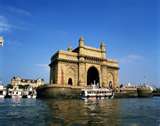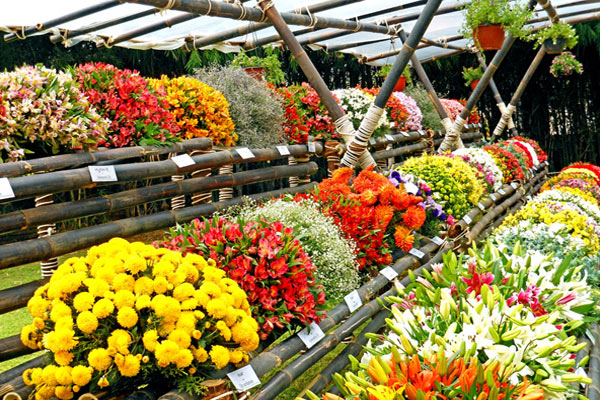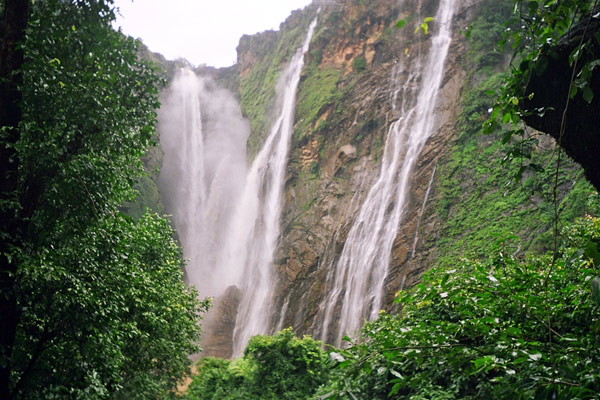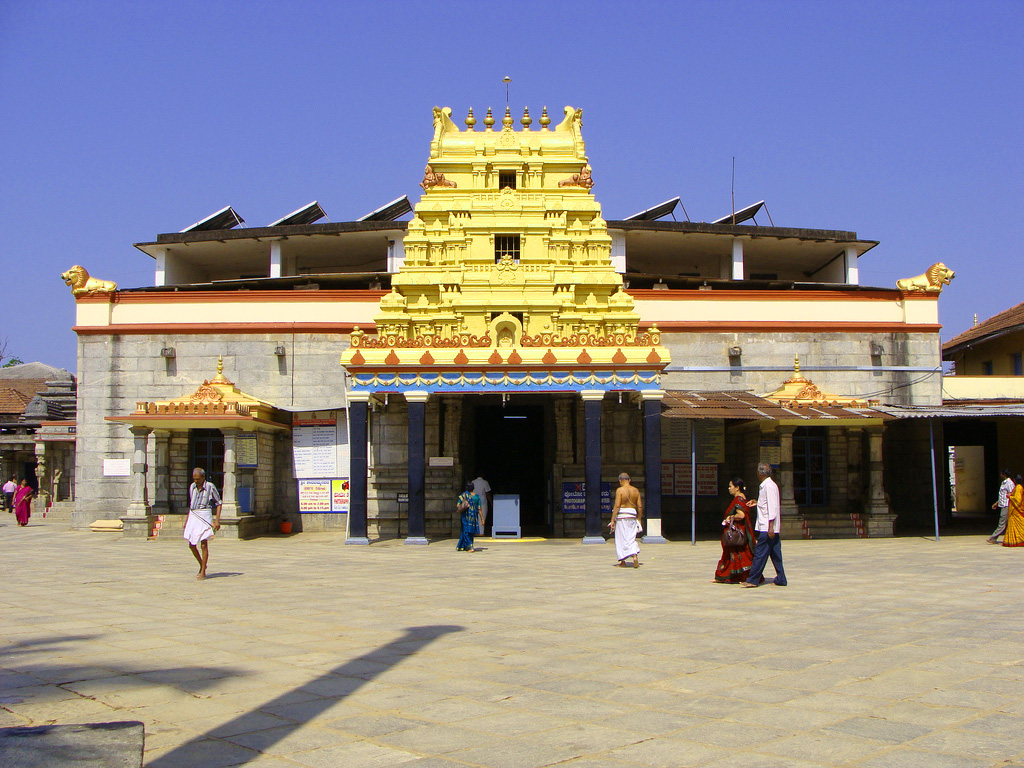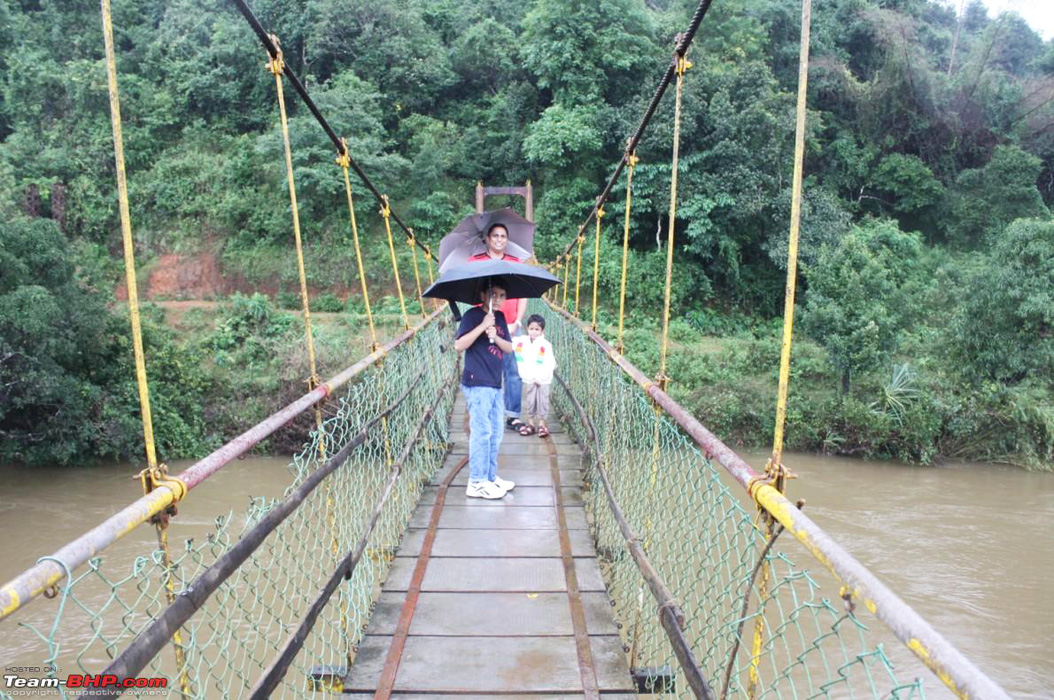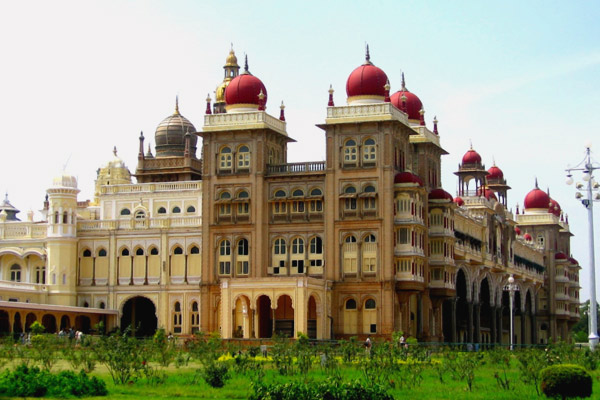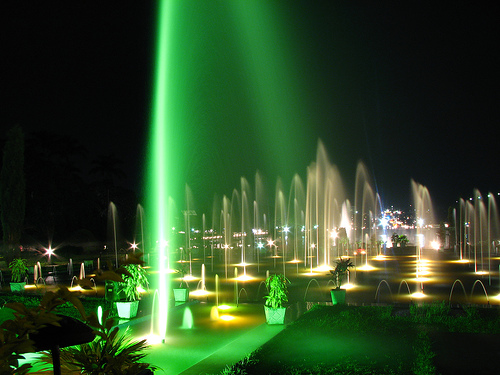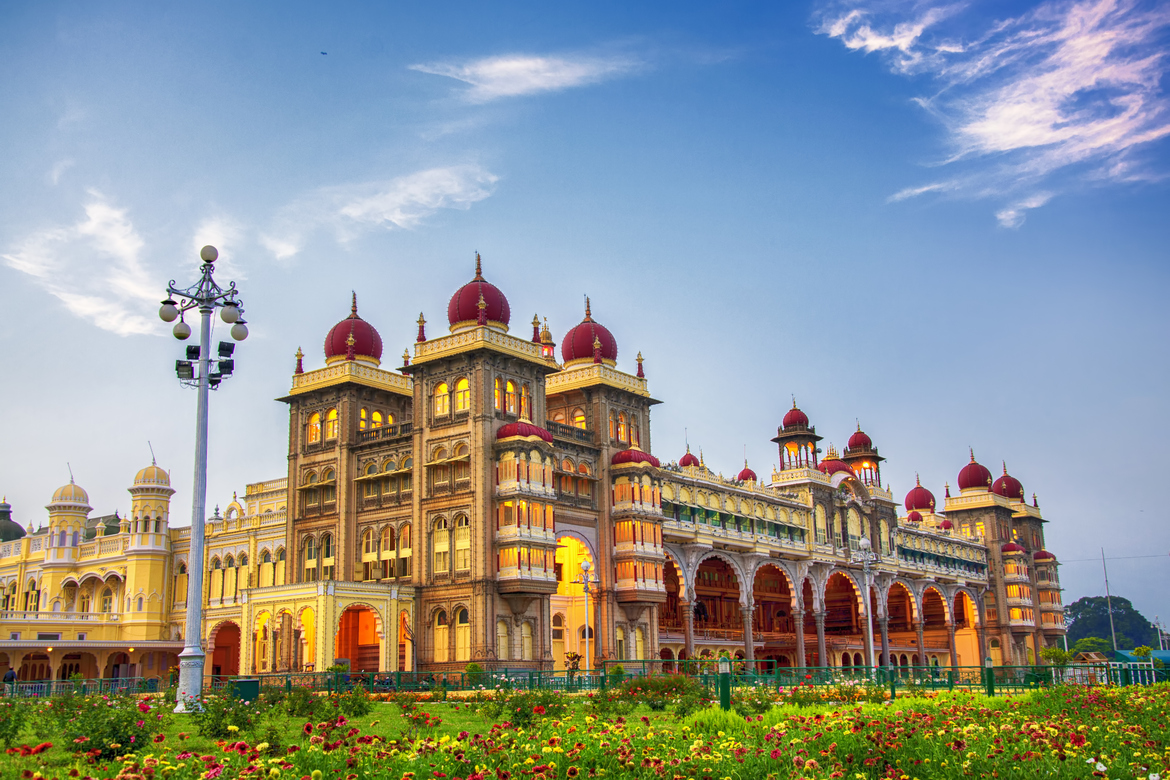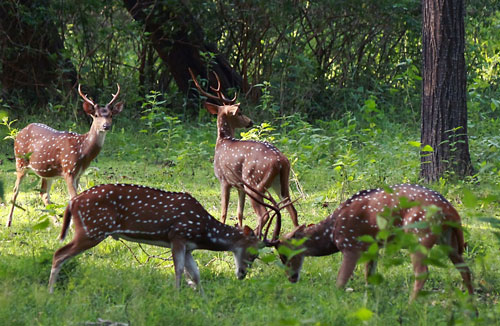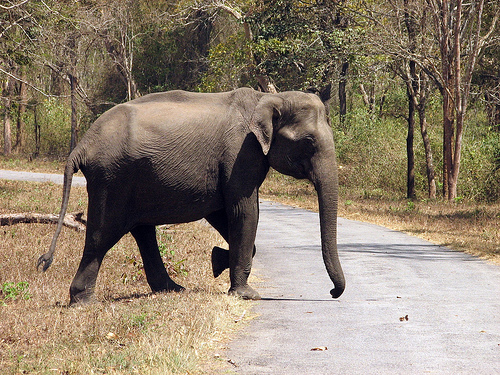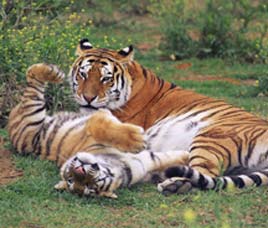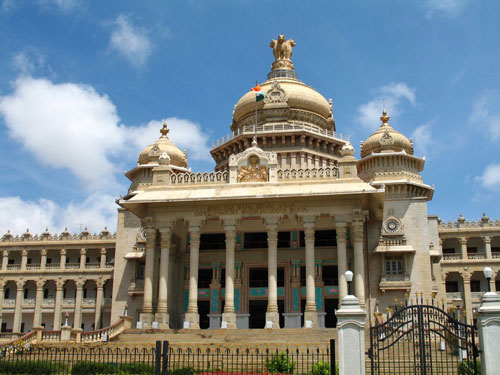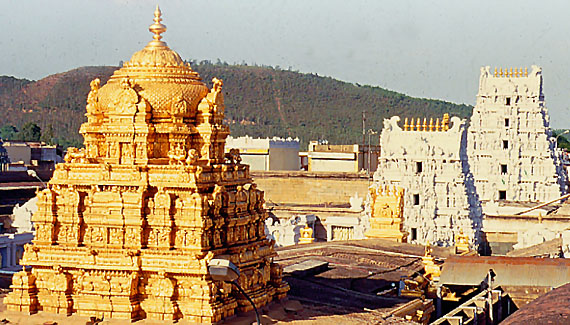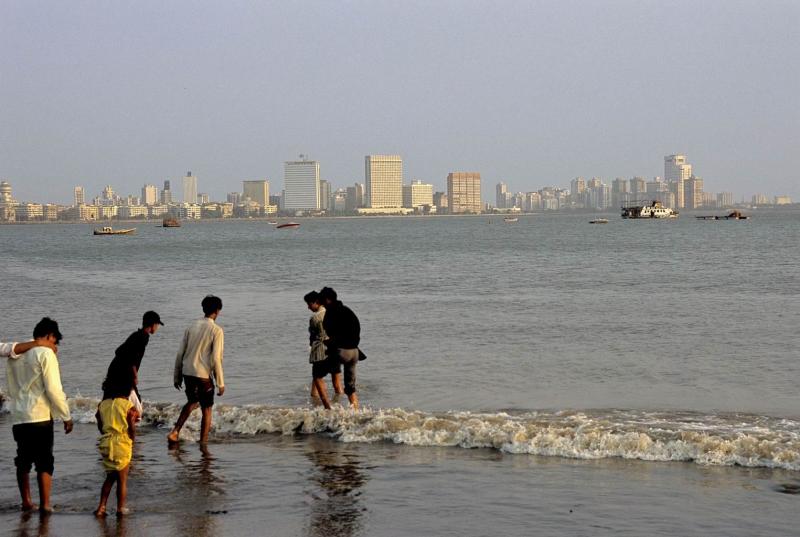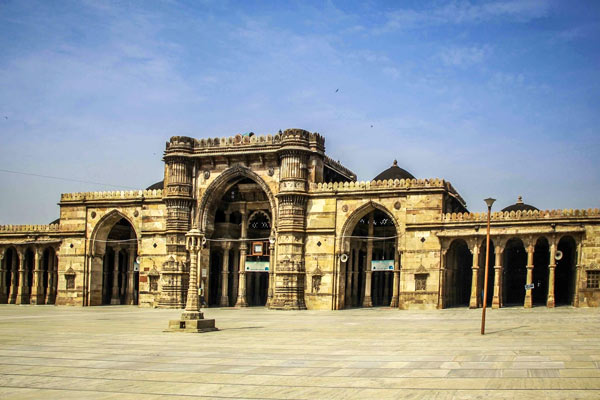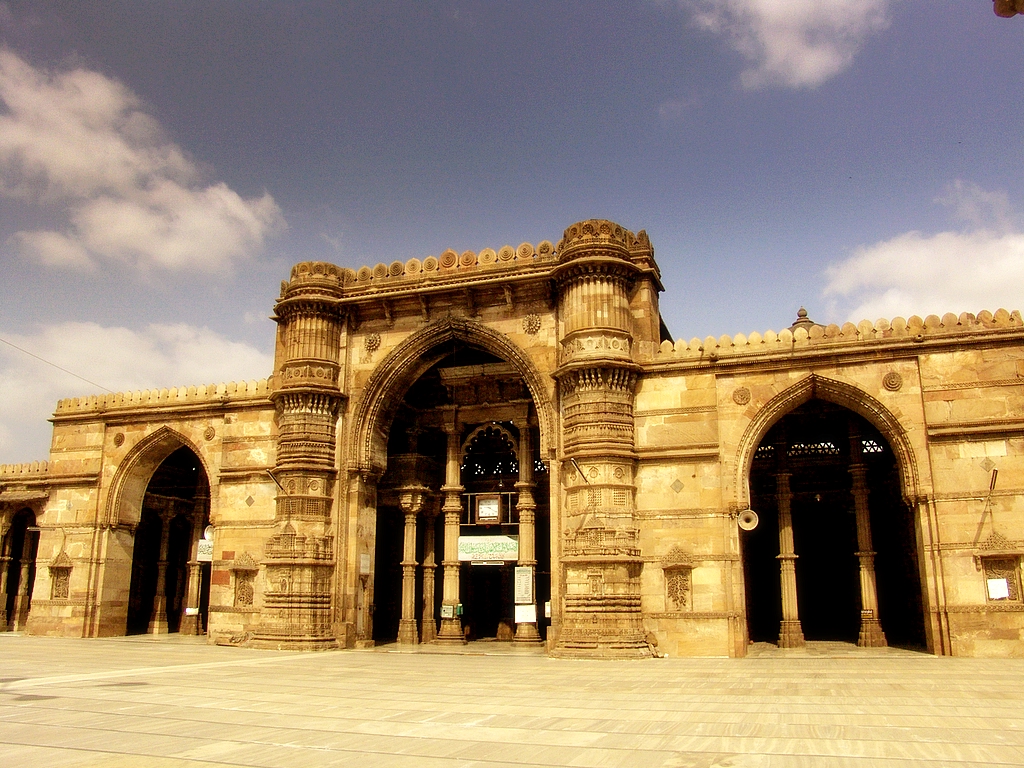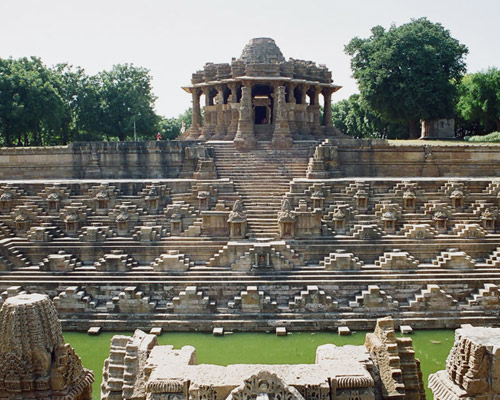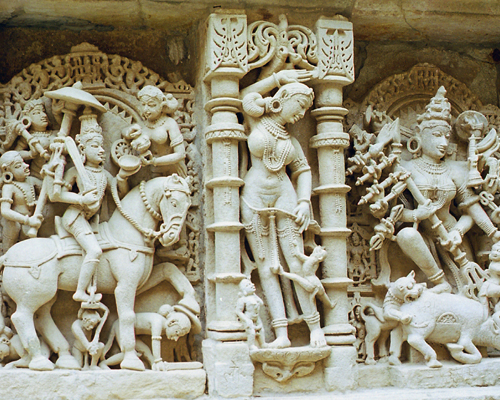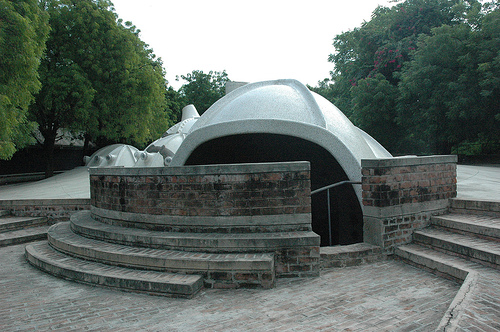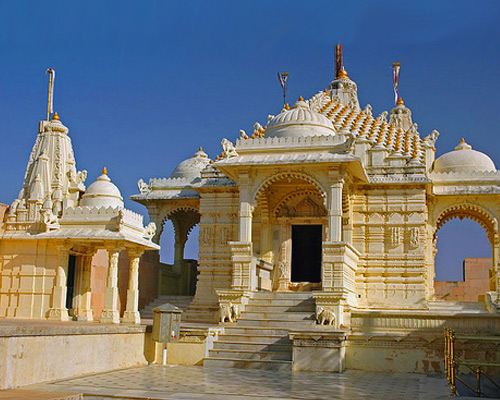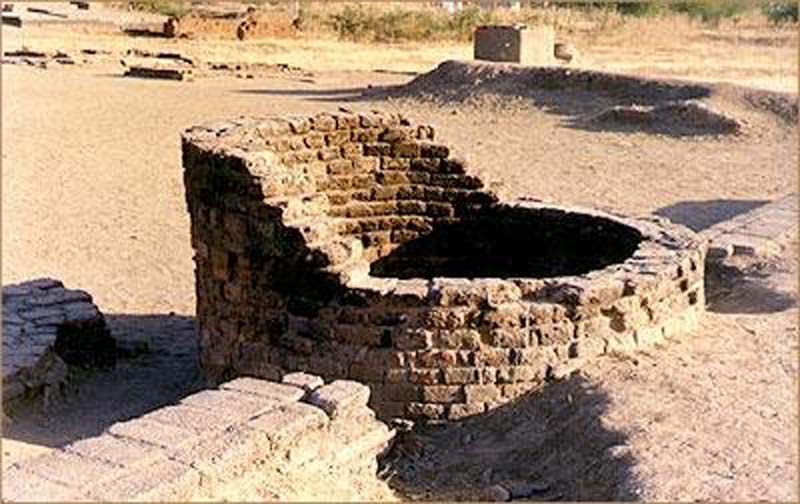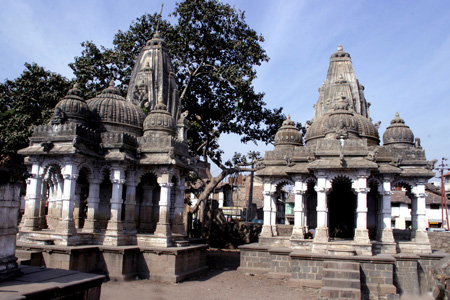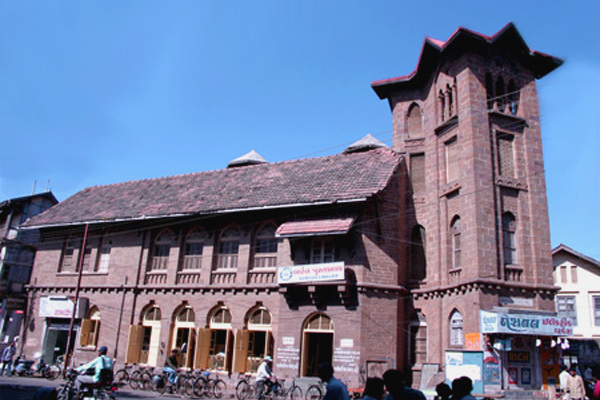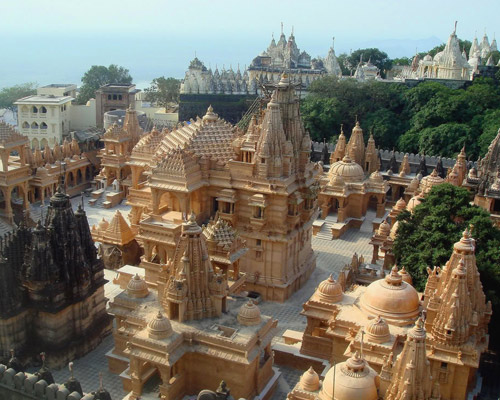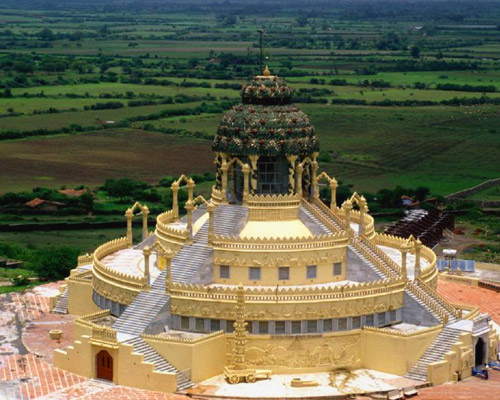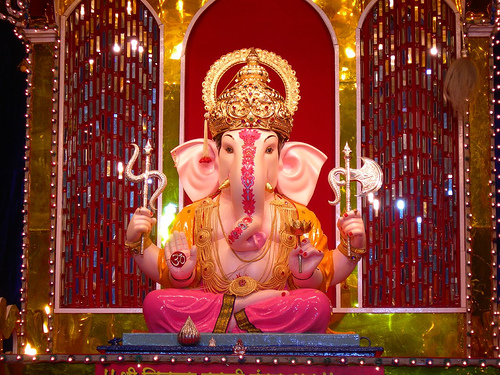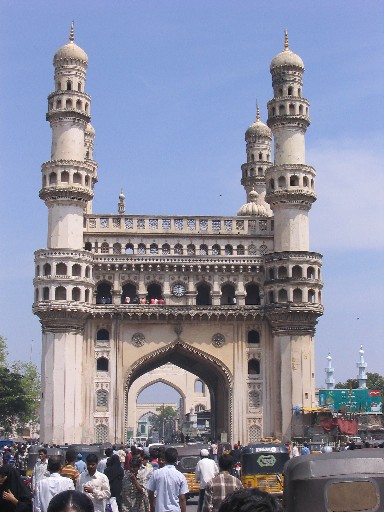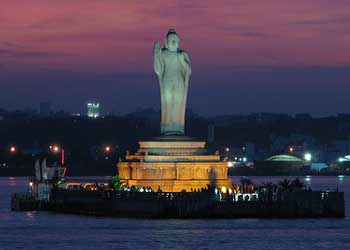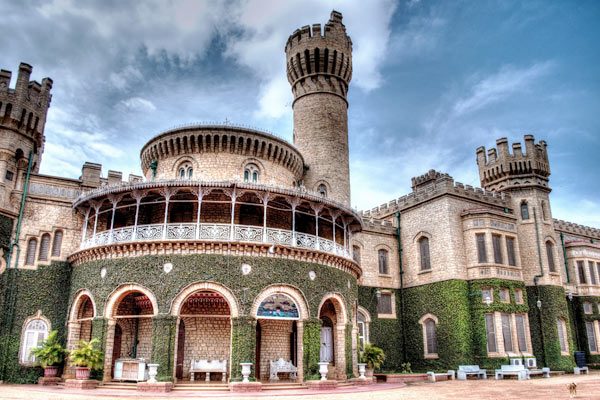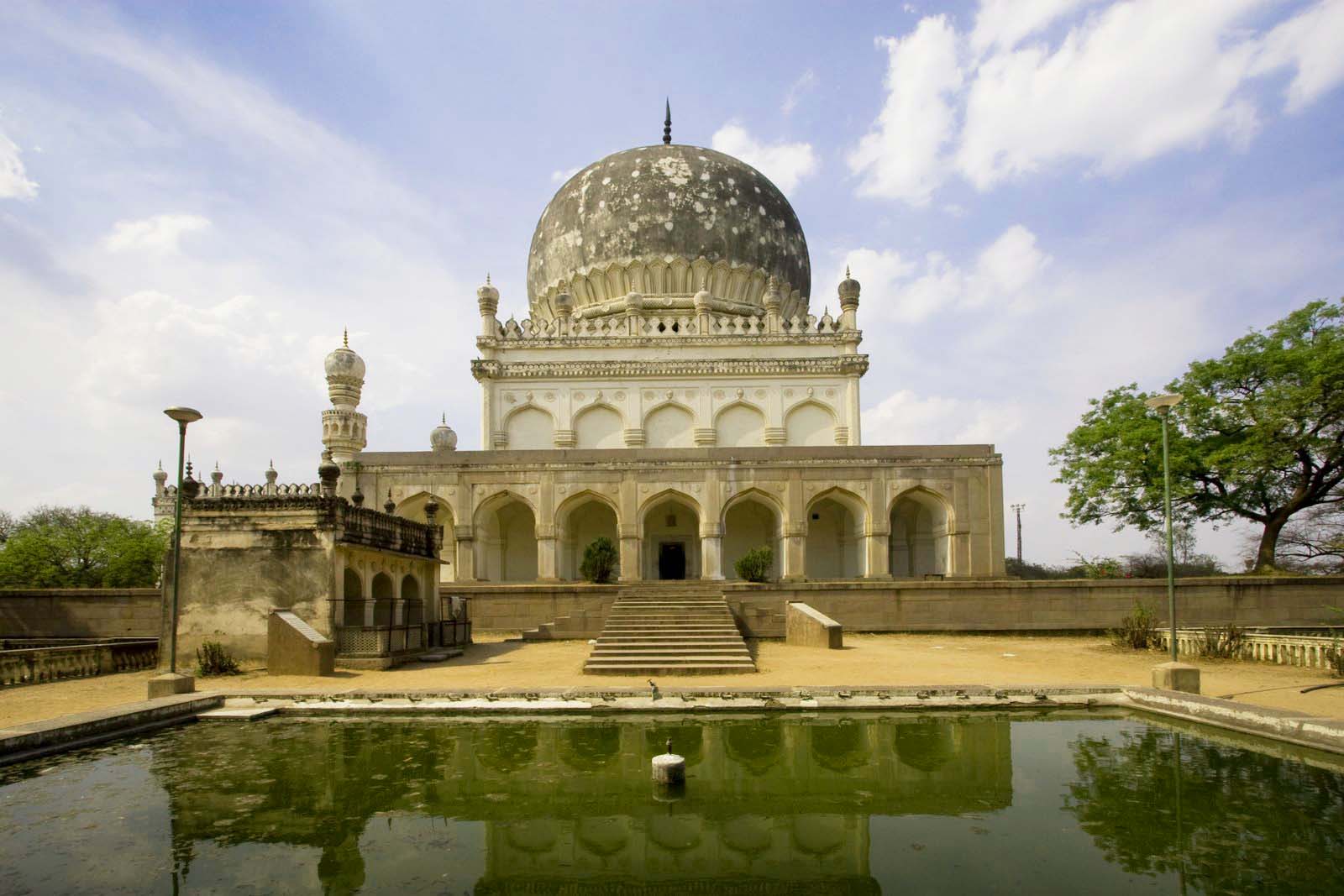GUJARAT & KARNATKA
Mumbai-Ahmedabad-Khumbariya-Ambaji-Palanpur-Patan-Modhera-Ahmedabad-Lothal-Bhavnagar-Palitana-Bhavnagar-Mumbai-Hyderabad-Bengaluru-Chikmaglur-Mysore-Nagarhole-Bengaluru
Day 1: Mumbai
 Upon arrival at Mumbai's international airport, you will be met by our representative and transferred to your hotel.
Upon arrival at Mumbai's international airport, you will be met by our representative and transferred to your hotel.
 This morning, you transfer to the airport to board your flight to Ahmadabad. On arrival, you are greeted and transferred to your hotel.
This morning, you transfer to the airport to board your flight to Ahmadabad. On arrival, you are greeted and transferred to your hotel.
Day 3: Ahmedabad
 Following breakfast, you set out on a drive to Balaram. Along the way, you will stop to visit Khumbariya, an important Jain pilgrim center and site of a beautiful Jain temple. From here, continue driving to Ambaji in the Banaskantha district of Gujarat. Here, Ambaji Temple is the holy seat of Ambe Mata - the Mother Goddess, and it is a place of pilgrimage for Hindus. The temple is also considered one of the Shakti Peethas, holy places of worship for the goddess Shakti. The goddess is a manifestation of Shivas consort, Parvati. Ambe Mata is the Adya Shakti – the primordial female power, the Mother Goddess. Upon arrival, check into Resort.
Following breakfast, you set out on a drive to Balaram. Along the way, you will stop to visit Khumbariya, an important Jain pilgrim center and site of a beautiful Jain temple. From here, continue driving to Ambaji in the Banaskantha district of Gujarat. Here, Ambaji Temple is the holy seat of Ambe Mata - the Mother Goddess, and it is a place of pilgrimage for Hindus. The temple is also considered one of the Shakti Peethas, holy places of worship for the goddess Shakti. The goddess is a manifestation of Shivas consort, Parvati. Ambe Mata is the Adya Shakti – the primordial female power, the Mother Goddess. Upon arrival, check into Resort.
Day 4: Ahmedabad - Khumbariya
 After breakfast, you drive to <a class="PIInfosoft-placeName" onclick="openAttractionDescriptionPopup('en', 'A18','AMD','IND','India');" data-target="#PopUp5" href="javascript:void(0)" data-toggle="modal">Patan</a>, once the capital of medieval Gujarat. This ancient fortified town was founded in 745 AD. It is known for its Hindu and Jain architecture such as Rani-ki-Vav, an 11th century step well, and Dhanderwad Jain Temple. <a class="PIInfosoft-placeName" onclick="openAttractionDescriptionPopup('en', 'A18','AMD','IND','India');" data-target="#PopUp5" href="javascript:void(0)" data-toggle="modal">Patan</a> is also famous for the textile art of patola saree (sari), an intricate form of double ikkat weaving. You will meet with one of three families known for their unique patola weaving. One patola sari can take up to six months to complete, so demanding is this patola art form. Continue on to <a class="PIInfosoft-placeName" onclick="openAttractionDescriptionPopup('en', 'A22','AMD','IND','India');" data-target="#PopUp5" href="javascript:void(0)" data-toggle="modal">Modhera</a>, made famous by its Sun Temple built in 1026 during the reign of the Solanki dynasty. This exquisitely carved temple is dedicated to the Sun God and stands high on an elevated platform overlooking a deep stepped tank. Arrive in Ahmedabad and check in your hotel. This afternoon, with your guide, tour Ahmadabad, the city of Ahmed Shah (the medieval ruler of Gujarat),known for its rich past and its association with Mahatma Gandhi, who had a residence, here. The unique style of architecture here is a blend of Hindu and Islamic styles, known as Indo-Saracenic style. Some of the monuments here date back to the 15th century. Visit the Jamma Masjid built in 1423 by the founder of Ahmedabad. The mosque is built in yellow sand stone and stands on the 260 pillars that support 15 domes as staggered elevations.
After breakfast, you drive to <a class="PIInfosoft-placeName" onclick="openAttractionDescriptionPopup('en', 'A18','AMD','IND','India');" data-target="#PopUp5" href="javascript:void(0)" data-toggle="modal">Patan</a>, once the capital of medieval Gujarat. This ancient fortified town was founded in 745 AD. It is known for its Hindu and Jain architecture such as Rani-ki-Vav, an 11th century step well, and Dhanderwad Jain Temple. <a class="PIInfosoft-placeName" onclick="openAttractionDescriptionPopup('en', 'A18','AMD','IND','India');" data-target="#PopUp5" href="javascript:void(0)" data-toggle="modal">Patan</a> is also famous for the textile art of patola saree (sari), an intricate form of double ikkat weaving. You will meet with one of three families known for their unique patola weaving. One patola sari can take up to six months to complete, so demanding is this patola art form. Continue on to <a class="PIInfosoft-placeName" onclick="openAttractionDescriptionPopup('en', 'A22','AMD','IND','India');" data-target="#PopUp5" href="javascript:void(0)" data-toggle="modal">Modhera</a>, made famous by its Sun Temple built in 1026 during the reign of the Solanki dynasty. This exquisitely carved temple is dedicated to the Sun God and stands high on an elevated platform overlooking a deep stepped tank. Arrive in Ahmedabad and check in your hotel. This afternoon, with your guide, tour Ahmadabad, the city of Ahmed Shah (the medieval ruler of Gujarat),known for its rich past and its association with Mahatma Gandhi, who had a residence, here. The unique style of architecture here is a blend of Hindu and Islamic styles, known as Indo-Saracenic style. Some of the monuments here date back to the 15th century. Visit the Jamma Masjid built in 1423 by the founder of Ahmedabad. The mosque is built in yellow sand stone and stands on the 260 pillars that support 15 domes as staggered elevations.
Day 5: Khumbariya
 Following breakfast, you visit Siddi Saiyad Mosque, which is enclosed by a pleasant garden in the center of the city. This small mosque is known for its delicate and exquisite trellises and stone window tracery. The Hathee Singh Temple is another Jain temple, built in 1848 of white marble with rich ornamentation. One of many Jain temples here, this one is dedicated to the Dharmanath, the 15th Jain Tirthankar. You continue your drive to the ancient city of <a class="PIInfosoft-placeName" onclick="openAttractionDescriptionPopup('en', 'A21','AMD','IND','India');" data-target="#PopUp5" href="javascript:void(0)" data-toggle="modal">Lothal</a>, well known as far back as Indus valley civilization. The origin and history of <a class="PIInfosoft-placeName" onclick="openAttractionDescriptionPopup('en', 'A21','AMD','IND','India');" data-target="#PopUp5" href="javascript:void(0)" data-toggle="modal">Lothal</a> can be dated back to 2400 BC. <a class="PIInfosoft-placeName" onclick="openAttractionDescriptionPopup('en', 'A21','AMD','IND','India');" data-target="#PopUp5" href="javascript:void(0)" data-toggle="modal">Lothal</a> is one of Gujarat's primary sites of archaeology. It was actively involved in the trade of beads, gems and expensive ornaments exported to West Asia and Africa. It is believed that the scientists of <a class="PIInfosoft-placeName" onclick="openAttractionDescriptionPopup('en', 'A21','AMD','IND','India');" data-target="#PopUp5" href="javascript:void(0)" data-toggle="modal">Lothal</a> were the ones to initiate the study of stars and advanced navigation. The archaeological excavations that were carried out led to the discovery of the town, a dock, mound and a marketplace. Areas lying nearby the excavated sites include an archaeological museum with Indus-era antiquities. From here, drive to Bhavnagar, founded in 1724. It was once the princely state of the Maharaja of Bhavnagar. Bhavnagar is dotted with a number of lakes and temples as well as being the home of the century-old Samaldas College, where Mahatma Gandhi once studied. Upon arrival in Bhavnagar, check into your hotel.
Following breakfast, you visit Siddi Saiyad Mosque, which is enclosed by a pleasant garden in the center of the city. This small mosque is known for its delicate and exquisite trellises and stone window tracery. The Hathee Singh Temple is another Jain temple, built in 1848 of white marble with rich ornamentation. One of many Jain temples here, this one is dedicated to the Dharmanath, the 15th Jain Tirthankar. You continue your drive to the ancient city of <a class="PIInfosoft-placeName" onclick="openAttractionDescriptionPopup('en', 'A21','AMD','IND','India');" data-target="#PopUp5" href="javascript:void(0)" data-toggle="modal">Lothal</a>, well known as far back as Indus valley civilization. The origin and history of <a class="PIInfosoft-placeName" onclick="openAttractionDescriptionPopup('en', 'A21','AMD','IND','India');" data-target="#PopUp5" href="javascript:void(0)" data-toggle="modal">Lothal</a> can be dated back to 2400 BC. <a class="PIInfosoft-placeName" onclick="openAttractionDescriptionPopup('en', 'A21','AMD','IND','India');" data-target="#PopUp5" href="javascript:void(0)" data-toggle="modal">Lothal</a> is one of Gujarat's primary sites of archaeology. It was actively involved in the trade of beads, gems and expensive ornaments exported to West Asia and Africa. It is believed that the scientists of <a class="PIInfosoft-placeName" onclick="openAttractionDescriptionPopup('en', 'A21','AMD','IND','India');" data-target="#PopUp5" href="javascript:void(0)" data-toggle="modal">Lothal</a> were the ones to initiate the study of stars and advanced navigation. The archaeological excavations that were carried out led to the discovery of the town, a dock, mound and a marketplace. Areas lying nearby the excavated sites include an archaeological museum with Indus-era antiquities. From here, drive to Bhavnagar, founded in 1724. It was once the princely state of the Maharaja of Bhavnagar. Bhavnagar is dotted with a number of lakes and temples as well as being the home of the century-old Samaldas College, where Mahatma Gandhi once studied. Upon arrival in Bhavnagar, check into your hotel.
Day 6: Ambaji
 This morning, explore Bhavnagar, where you discover <a class="PIInfosoft-placeName" onclick="openAttractionDescriptionPopup('en', 'A1K','BHU','IND','India');" data-target="#PopUp5" href="javascript:void(0)" data-toggle="modal">Gandhi Smriti</a>, a memorial opened to the public in 1955. It has a Gandhi picture gallery, Khadi Gramodyog Bhandar (small village weavers and shop) and a library, where you can learn about the life and works of Mahatma Gandhi. It also has a museum with an interesting collection of coins. Takteshwar Temple was built in the late 19th century of pure marble. On a hill adjacent to the railway station, it offers magnificent views. Next, travel to <a class="PIInfosoft-placeName" onclick="openAttractionDescriptionPopup('en', 'A1P','BHU','IND','India');" data-target="#PopUp5" href="javascript:void(0)" data-toggle="modal">Palitana</a>, an important Jain pilgrimage site in Gujarat. There are more than 3,000 temples in the hills around here. However, it is Shatrunjay hill, which has more than 900 Jain temples, that is the most holy. You have the rare opportunity to join pilgrims on a climb to the top via more than 3,800 stone steps. The temples on the mountain as well as the mountain itself are the most sacred places (tirtha) for the Jain community. Every devout Jain aspires to climb to the top of the mountain at least once in a lifetime. While on the top, travelers can also visit a Muslim shrine of Angar Pir. These hills were sanctified by Lord Rishabha, the first tirthankara of Jainism, who gave his first sermon in the temple on the hilltop. It is also said to be the place where three Pandavas reached enlightenment, Nirvana. One of the most important temples here is the Digamber Jain Temple, which encompasses nine shrines with the idols of all 24 Jain Tirthankarars. The main shrine contains the idol of 1008 Bhagwan Shantinath, made of white stone. According to the Jain calendar, it was installed here in 1686. The temple also houses beautiful idols of Yudhishthir, Bheem and Arjun. Two other idols of Bhagwan Parsavnath are located here.
This morning, explore Bhavnagar, where you discover <a class="PIInfosoft-placeName" onclick="openAttractionDescriptionPopup('en', 'A1K','BHU','IND','India');" data-target="#PopUp5" href="javascript:void(0)" data-toggle="modal">Gandhi Smriti</a>, a memorial opened to the public in 1955. It has a Gandhi picture gallery, Khadi Gramodyog Bhandar (small village weavers and shop) and a library, where you can learn about the life and works of Mahatma Gandhi. It also has a museum with an interesting collection of coins. Takteshwar Temple was built in the late 19th century of pure marble. On a hill adjacent to the railway station, it offers magnificent views. Next, travel to <a class="PIInfosoft-placeName" onclick="openAttractionDescriptionPopup('en', 'A1P','BHU','IND','India');" data-target="#PopUp5" href="javascript:void(0)" data-toggle="modal">Palitana</a>, an important Jain pilgrimage site in Gujarat. There are more than 3,000 temples in the hills around here. However, it is Shatrunjay hill, which has more than 900 Jain temples, that is the most holy. You have the rare opportunity to join pilgrims on a climb to the top via more than 3,800 stone steps. The temples on the mountain as well as the mountain itself are the most sacred places (tirtha) for the Jain community. Every devout Jain aspires to climb to the top of the mountain at least once in a lifetime. While on the top, travelers can also visit a Muslim shrine of Angar Pir. These hills were sanctified by Lord Rishabha, the first tirthankara of Jainism, who gave his first sermon in the temple on the hilltop. It is also said to be the place where three Pandavas reached enlightenment, Nirvana. One of the most important temples here is the Digamber Jain Temple, which encompasses nine shrines with the idols of all 24 Jain Tirthankarars. The main shrine contains the idol of 1008 Bhagwan Shantinath, made of white stone. According to the Jain calendar, it was installed here in 1686. The temple also houses beautiful idols of Yudhishthir, Bheem and Arjun. Two other idols of Bhagwan Parsavnath are located here.
Day 7: Palanpur
 Transfer to the airport to board your flight to Hyderabad. Upon arrival, you are welcomed by a our representative and transferred to your heritage hotel, a former palace built in 1894. It took ten years and four million rupees to construct this unique palace in the shape of a scorpion. Designed by British architect William Mard Marret, the palace took a rumored 22 years to perfect. It was crafted with Italian marble. It is a rare blend of Italian and Tudor architecture. It has been owned in turn by Sir Vicar-Ul-Umra, prime minister of the State of Hyderabad, Nizam Mahboob Ali Pasha and Mir Osman Ali Khan Bahadur. This afternoon, enjoy a fascinating tour with a palace historian. The residence of Nizam VI until 1911, <a class="PIInfosoft-placeName" onclick="openAttractionDescriptionPopup('en', 'AK1','HYD','IND','India');" data-target="#PopUp5" href="javascript:void(0)" data-toggle="modal">Falaknuma Palace</a> was later used as a royal guesthouse for dignitaries, including free Indias first president Dr. Rajendra Prasad in 1951. Echoes of visiting European monarchs, the Duke of Windsor, heads of state and distinguished governors seem to ring through inner sanctum of Hyderabad. Since 1995, Taj Group of Hotels has sensitively restored the palace, including 60 elegant rooms and suites. The palace is one of the finest the region. The palace houses a large collection of rare treasures including paintings, statues, furniture, manuscripts and a jade collection considered to be unique in the world.
Transfer to the airport to board your flight to Hyderabad. Upon arrival, you are welcomed by a our representative and transferred to your heritage hotel, a former palace built in 1894. It took ten years and four million rupees to construct this unique palace in the shape of a scorpion. Designed by British architect William Mard Marret, the palace took a rumored 22 years to perfect. It was crafted with Italian marble. It is a rare blend of Italian and Tudor architecture. It has been owned in turn by Sir Vicar-Ul-Umra, prime minister of the State of Hyderabad, Nizam Mahboob Ali Pasha and Mir Osman Ali Khan Bahadur. This afternoon, enjoy a fascinating tour with a palace historian. The residence of Nizam VI until 1911, <a class="PIInfosoft-placeName" onclick="openAttractionDescriptionPopup('en', 'AK1','HYD','IND','India');" data-target="#PopUp5" href="javascript:void(0)" data-toggle="modal">Falaknuma Palace</a> was later used as a royal guesthouse for dignitaries, including free Indias first president Dr. Rajendra Prasad in 1951. Echoes of visiting European monarchs, the Duke of Windsor, heads of state and distinguished governors seem to ring through inner sanctum of Hyderabad. Since 1995, Taj Group of Hotels has sensitively restored the palace, including 60 elegant rooms and suites. The palace is one of the finest the region. The palace houses a large collection of rare treasures including paintings, statues, furniture, manuscripts and a jade collection considered to be unique in the world.
Day 8: Palanpur - Patan
 Established in 1591, Hyderabad was known for its pearl and diamond trading centers. Explore <a class="PIInfosoft-placeName" onclick="openAttractionDescriptionPopup('en', 'AI1','HYD','IND','India');" data-target="#PopUp5" href="javascript:void(0)" data-toggle="modal">Golconda</a> Fort, famous for its acoustics, palaces and ingenious water supply system. One of the most magnificent fort complexes in the country, it was built consecutively by three dynasties, the Kakatiyas, the Bahmanis and primarily by the Qutub Shahis. The tombs of the seven Qutub Shahi rulers in the Ibrahim Bagh (garden precinct) are located close to the fort. The galleries of the smaller tombs are a single story while the larger tombs comprise two stories. In the center of each tomb, a sarcophagus overlies the actual burial vault in a crypt below. The domed ceilings were originally overlaid with blue and green tiles, of which only a few pieces now remain. This afternoon, you explore the old city south of the original Hyderabad settlement. In the heart is <a class="PIInfosoft-placeName" onclick="openAttractionDescriptionPopup('en', 'AH1','HYD','IND','India');" data-target="#PopUp5" href="javascript:void(0)" data-toggle="modal">Charminar</a>, the symbol of the city on the east bank of Musi River. This iconic monument has four minarets and small mosque on the roof. Enjoy a stroll around the bazaars in the old city.
Established in 1591, Hyderabad was known for its pearl and diamond trading centers. Explore <a class="PIInfosoft-placeName" onclick="openAttractionDescriptionPopup('en', 'AI1','HYD','IND','India');" data-target="#PopUp5" href="javascript:void(0)" data-toggle="modal">Golconda</a> Fort, famous for its acoustics, palaces and ingenious water supply system. One of the most magnificent fort complexes in the country, it was built consecutively by three dynasties, the Kakatiyas, the Bahmanis and primarily by the Qutub Shahis. The tombs of the seven Qutub Shahi rulers in the Ibrahim Bagh (garden precinct) are located close to the fort. The galleries of the smaller tombs are a single story while the larger tombs comprise two stories. In the center of each tomb, a sarcophagus overlies the actual burial vault in a crypt below. The domed ceilings were originally overlaid with blue and green tiles, of which only a few pieces now remain. This afternoon, you explore the old city south of the original Hyderabad settlement. In the heart is <a class="PIInfosoft-placeName" onclick="openAttractionDescriptionPopup('en', 'AH1','HYD','IND','India');" data-target="#PopUp5" href="javascript:void(0)" data-toggle="modal">Charminar</a>, the symbol of the city on the east bank of Musi River. This iconic monument has four minarets and small mosque on the roof. Enjoy a stroll around the bazaars in the old city.
 This morning, stroll through the Salar Jung Museum, which houses collections ranging from 2nd century BC to early 20th century; and encompass cultures that include Greek, Roman, Hindu, Jain, Buddhist, Christian and Islamic from many countries. This is one of the few Indian museums, which can boast of an extensive collection of far Eastern art consisting of Sino-Japanese art objects of porcelain, bronze, enamel, lacquer ware, embroidery, paintings, wood and inlay work. The European collection comprises art objects that include oil paintings, glass objects, majestic furniture, and splendid examples of ivory, enamelware and clocks. They also have a children's section. Transfer to the airport for your flight to Bangalore. On arrival, you are greeted by our representative and transferred to your hotel. This evening is at leisure.
This morning, stroll through the Salar Jung Museum, which houses collections ranging from 2nd century BC to early 20th century; and encompass cultures that include Greek, Roman, Hindu, Jain, Buddhist, Christian and Islamic from many countries. This is one of the few Indian museums, which can boast of an extensive collection of far Eastern art consisting of Sino-Japanese art objects of porcelain, bronze, enamel, lacquer ware, embroidery, paintings, wood and inlay work. The European collection comprises art objects that include oil paintings, glass objects, majestic furniture, and splendid examples of ivory, enamelware and clocks. They also have a children's section. Transfer to the airport for your flight to Bangalore. On arrival, you are greeted by our representative and transferred to your hotel. This evening is at leisure.
 After breakfast, you set out on a six-hour drive to Chikmagalur, stopping en route at Sravanabelagola, a renowned Jain holy pilgrimage center. Like most of this journey, you are not likely to meet many tourists. Indeed, most people who come here are on a pilgrimage. They come to climb the more than 600 steps up a hill to experience this remarkable statue and the small temple on top. The 10th-century statue was carved out of a single block of stone and, at more than 17 meters/57 feet tall. It is regarded as the largest Jain monolithic statue in the world, and features mmore than 800 inscriptions dating from 600 to 1830. Travel on to Chikmagalur and check into your hotel. This evening is free.
After breakfast, you set out on a six-hour drive to Chikmagalur, stopping en route at Sravanabelagola, a renowned Jain holy pilgrimage center. Like most of this journey, you are not likely to meet many tourists. Indeed, most people who come here are on a pilgrimage. They come to climb the more than 600 steps up a hill to experience this remarkable statue and the small temple on top. The 10th-century statue was carved out of a single block of stone and, at more than 17 meters/57 feet tall. It is regarded as the largest Jain monolithic statue in the world, and features mmore than 800 inscriptions dating from 600 to 1830. Travel on to Chikmagalur and check into your hotel. This evening is free.
Day 11: Ahmedabad
 This morning, discover the 12th century temples in the cities of Halebid and Belur. These two towns were at the heart of the Hoysala Empire that ruled most of the modern day state of Karnataka between the 10th and the 14th centuries. The capital was initially located at Belur but was later moved to Halebid. The Hoysala were patrons of art and architecture, and the empire is remembered today primarily for its temple architecture. More than a hundred surviving temples are scattered across Karnataka, including the well-known Chennakesava Temple at Belur, the Hoysaleswara Temple at Halebidu, and the Kesava Temple at Somanathapura. The Hoysala rulers also patronized the fine arts, encouraging literature and sculptures, some of which are so exotic, erotic and eloquent - that you almost expect them to speak or move.
This morning, discover the 12th century temples in the cities of Halebid and Belur. These two towns were at the heart of the Hoysala Empire that ruled most of the modern day state of Karnataka between the 10th and the 14th centuries. The capital was initially located at Belur but was later moved to Halebid. The Hoysala were patrons of art and architecture, and the empire is remembered today primarily for its temple architecture. More than a hundred surviving temples are scattered across Karnataka, including the well-known Chennakesava Temple at Belur, the Hoysaleswara Temple at Halebidu, and the Kesava Temple at Somanathapura. The Hoysala rulers also patronized the fine arts, encouraging literature and sculptures, some of which are so exotic, erotic and eloquent - that you almost expect them to speak or move.
Day 12: Ahmedabad - Lothal
 Travel to Mysore, a four-hour drive, and check into your hotel. Mysore was the capital city of the Kingdom of Mysore from 1399 until 1947. The city is known as the City of Palaces for several ornate examples that include Amba Vilas, popularly known as Mysore Palace; Jaganmohana Palace, which also serves as an art gallery; and Rajendra Vilas, also known as the summer palace. This afternoon, you will discover Mysore on a walking tour that shows you the city's colonial and royal past as well as 125-year-old market. If you are interested in art, you may wish to visit local artisans. The Mysore region contributes to 70% of India's sandalwood produce. The city is home to the world's largest group of inlay artisans. This ancient art form passed down over generations.
Travel to Mysore, a four-hour drive, and check into your hotel. Mysore was the capital city of the Kingdom of Mysore from 1399 until 1947. The city is known as the City of Palaces for several ornate examples that include Amba Vilas, popularly known as Mysore Palace; Jaganmohana Palace, which also serves as an art gallery; and Rajendra Vilas, also known as the summer palace. This afternoon, you will discover Mysore on a walking tour that shows you the city's colonial and royal past as well as 125-year-old market. If you are interested in art, you may wish to visit local artisans. The Mysore region contributes to 70% of India's sandalwood produce. The city is home to the world's largest group of inlay artisans. This ancient art form passed down over generations.
Day 13: Lothal - Bhavnagar
 Mysore is especially known for its annual Dasara Festival, a popular 10-day festival that usually is held in September or October. While this festival is celebrated in many areas of India, none more so than here. The last day of the festival, known as Vijayadashami, is the most auspicious day of Dasara. According to legend, Vijayadashami denotes the victory of truth over evil, and was the day the Hindu Goddess Chamundeshwari killed the demon Mahishasura. The procession is October 3, 2014, with a procession, Jumboo Savari, that begins at Mysore Palace. An idol of the Goddess Durga is carried through the crowds of celebrants on the back of an elaborately decorated elephant. This festival has been going on for more than 400 years.
Mysore is especially known for its annual Dasara Festival, a popular 10-day festival that usually is held in September or October. While this festival is celebrated in many areas of India, none more so than here. The last day of the festival, known as Vijayadashami, is the most auspicious day of Dasara. According to legend, Vijayadashami denotes the victory of truth over evil, and was the day the Hindu Goddess Chamundeshwari killed the demon Mahishasura. The procession is October 3, 2014, with a procession, Jumboo Savari, that begins at Mysore Palace. An idol of the Goddess Durga is carried through the crowds of celebrants on the back of an elaborately decorated elephant. This festival has been going on for more than 400 years.
Day 14: Bhavnagar
 This morning, you head outside the city to <a class="PIInfosoft-placeName" onclick="openAttractionDescriptionPopup('en', 'AHE','MYQ','IND','India');" data-target="#PopUp5" href="javascript:void(0)" data-toggle="modal">Chamundi Hills</a>, eight hills considered sacred. Chamundis main hill features a long stone stairway leading to the top of the hill via 1,008 steps. The first 600 steps are steeper than those higher up. En route to the top, you pass the large statue of Nandi the bull that was the vahana (vehicle) of Lord Shiva. You can also drive to the main temple. Then you travel on to Nagarhole. After you check in to your resort, you are free to pursue your own interests, or relax with a massage or other Ayurvedic treatment. Orange County, a luxury resort, was named by National Geographic Traveler as one of the 25 best ecolodges. The sustainable property works to improve their community by generating greater economic benefits to the local people through employment opportunities, use and promotion of local products, use of local suppliers, le, encourage and provide financial support for economic, social or environmental projects that will benefit local communities, insure that all employees are paid fair wages; and work to insure that products used are not made by child or bonded labor. Kabini also has a successful recycling program that includes early stage waste segregation and state-of-the-art sewage treatment plants. Segregated waste is sorted, removed and sold by locals, who benefit from it economically as much as the resort does ecologically.
This morning, you head outside the city to <a class="PIInfosoft-placeName" onclick="openAttractionDescriptionPopup('en', 'AHE','MYQ','IND','India');" data-target="#PopUp5" href="javascript:void(0)" data-toggle="modal">Chamundi Hills</a>, eight hills considered sacred. Chamundis main hill features a long stone stairway leading to the top of the hill via 1,008 steps. The first 600 steps are steeper than those higher up. En route to the top, you pass the large statue of Nandi the bull that was the vahana (vehicle) of Lord Shiva. You can also drive to the main temple. Then you travel on to Nagarhole. After you check in to your resort, you are free to pursue your own interests, or relax with a massage or other Ayurvedic treatment. Orange County, a luxury resort, was named by National Geographic Traveler as one of the 25 best ecolodges. The sustainable property works to improve their community by generating greater economic benefits to the local people through employment opportunities, use and promotion of local products, use of local suppliers, le, encourage and provide financial support for economic, social or environmental projects that will benefit local communities, insure that all employees are paid fair wages; and work to insure that products used are not made by child or bonded labor. Kabini also has a successful recycling program that includes early stage waste segregation and state-of-the-art sewage treatment plants. Segregated waste is sorted, removed and sold by locals, who benefit from it economically as much as the resort does ecologically.
 This morning you set out on a vehicle safari in <a class="PIInfosoft-placeName" onclick="openAttractionDescriptionPopup('en', 'NNP','NHL','IND','India');" data-target="#PopUp5" href="javascript:void(0)" data-toggle="modal">Nagarhole National Park</a>, accompanied by a naturalist guide. Its ecosystem supports the highest density of herbivores found in Asia. In addition to large herbivores such as the chital, sambar, gaur and Asian elephant, Nagarhole is also home to some of the world's rarest predators such as Bengal tiger, leopard and wild dog. During the summer months, the park has the largest congregation of Asian elephants in the world. Bird watchers enjoy spotting some of the more than 300 species recorded in the region! Depending on water levels, this afternoon you go on a safari by boat on the Kabini River through the park. As your boat slips upstream for the resort, the river separates the <a class="PIInfosoft-placeName" onclick="openAttractionDescriptionPopup('en', 'NNP','NHL','IND','India');" data-target="#PopUp5" href="javascript:void(0)" data-toggle="modal">Nagarhole National Park</a> from the Bandipur National Park. You may pass Asian elephants peacefully feeding, the marsh crocodile, smooth-coated otter and myriad water birds.
This morning you set out on a vehicle safari in <a class="PIInfosoft-placeName" onclick="openAttractionDescriptionPopup('en', 'NNP','NHL','IND','India');" data-target="#PopUp5" href="javascript:void(0)" data-toggle="modal">Nagarhole National Park</a>, accompanied by a naturalist guide. Its ecosystem supports the highest density of herbivores found in Asia. In addition to large herbivores such as the chital, sambar, gaur and Asian elephant, Nagarhole is also home to some of the world's rarest predators such as Bengal tiger, leopard and wild dog. During the summer months, the park has the largest congregation of Asian elephants in the world. Bird watchers enjoy spotting some of the more than 300 species recorded in the region! Depending on water levels, this afternoon you go on a safari by boat on the Kabini River through the park. As your boat slips upstream for the resort, the river separates the <a class="PIInfosoft-placeName" onclick="openAttractionDescriptionPopup('en', 'NNP','NHL','IND','India');" data-target="#PopUp5" href="javascript:void(0)" data-toggle="modal">Nagarhole National Park</a> from the Bandipur National Park. You may pass Asian elephants peacefully feeding, the marsh crocodile, smooth-coated otter and myriad water birds.
 Continue your exploration of the area on safari or on guided nature walks. You can opt to learn about Asian elephants during an informal talk by a naturalist. Learn about this magnificent animal, its natural history and its long association with man. Meet Meenakshi, the resident elephant, and participate in bathing or feeding Meenakshi. Go on a bird watching trek or relax with a massage or other Ayurvedic treatments.
Continue your exploration of the area on safari or on guided nature walks. You can opt to learn about Asian elephants during an informal talk by a naturalist. Learn about this magnificent animal, its natural history and its long association with man. Meet Meenakshi, the resident elephant, and participate in bathing or feeding Meenakshi. Go on a bird watching trek or relax with a massage or other Ayurvedic treatments.
Day 17: Bhavnagar
 Today you are transferred to Bangalore for your onward flight
Today you are transferred to Bangalore for your onward flight

